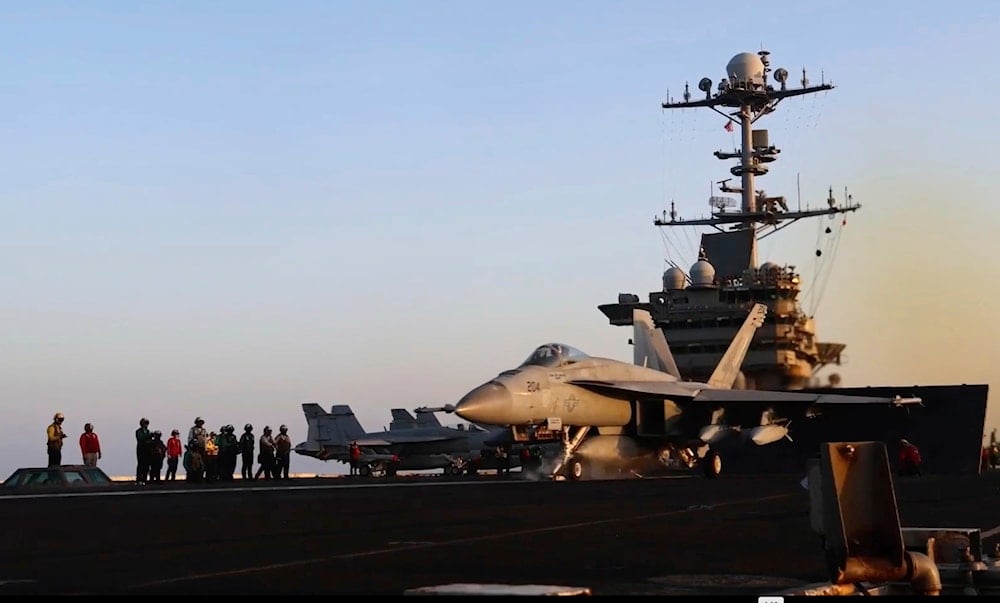Yemen pushes US Navy to limits with advanced drone, missile war: WSJ
After months of high-risk naval operations in the Red Sea, the USS Truman loses another jet as US forces struggle to counter Ansar Allah’s evolving missile and drone tactics.
-

This image, taken from video provided by the US Navy, shows an aircraft launching from the USS Harry S. Truman in the Red Sea before airstrikes in Sanaa, Yemen, Saturday, March 15, 2025. (US Navy via AP)
A $67 million F/A-18 Super Hornet crashed into the Red Sea on May 6 after a landing malfunction aboard the USS Harry S. Truman, marking the third jet lost by the carrier in under five months, an incident that, according to The Wall Street Journal, unfolded just hours after President Trump abruptly declared a ceasefire with Yemen’s Ansar Allah movement, leaving Pentagon officials scrambling to respond.
Deployed since December 2024, the USS Truman has been at the center of the Red Sea naval war 2025, tasked with containing Yemeni missile and drone attacks. This high-stakes mission has evolved into one of the most intense maritime operations in decades, highlighting the US Navy’s growing vulnerability in modern asymmetric warfare.
The crash, described by Navy officials as “unprecedented", has further raised concerns about operational strain and systemic risk within the Truman strike group, as per the report. In addition to three jet losses, the group has also experienced a collision at sea. The Navy and Central Command (Centcom) have not publicly addressed the causes under investigation.
Trump’s ceasefire announcement with Ansar Allah, delivered without Pentagon coordination, shocked senior defense officials. Military leaders fear that the abrupt halt could compromise leverage in a campaign where the US has invested over $1.5 billion in munitions and deployed roughly 30 ships, or 10% of its active fleet.
YAF reshapes modern naval warfare
Ansar Allah fighters, often operating from caves and improvised launch sites, have reshaped naval warfare by deploying drones and missiles, becoming the first non-state group to use anti-ship ballistic missiles in combat. Their evolving tactics, The Wall Street Journal reported, mirror the drone-driven transformation of warfare seen in Ukraine, enabling relatively low-cost operations against a technologically superior adversary.
The Red Sea’s narrow geography plays to Ansar Allah’s advantage. US ships, often within visual range of the Yemeni coastline, struggle to maneuver freely. Former Navy strategist Bryan Clark warned that “you make it a sitting duck out there and within range of Houthi weapons.” The terrain and persistent threat environment have upended traditional assumptions about naval dominance.
Sounding alarms over long-term effects
Military leaders and lawmakers alike are sounding alarms over the campaign’s long-term effects. The USS Truman aircraft crash is just one sign of broader fatigue. Rep. Ken Calvert (R-Calif.) warned during a May 14 hearing that “this persistent operational tempo comes at a cost,” citing delayed maintenance, overstretched crews, and diverted attention from China.
The Navy’s attempt to sustain high-intensity operations led to the establishment of a rearming port in the Red Sea, an unprecedented move that officials described as “game-changing". Yet, even with that logistical breakthrough, readiness concerns persist, and the US Navy’s Red Sea strategy faces scrutiny from within, the report stressed.
Earlier in the campaign, two Navy SEALs were lost off Somalia during an "interdiction operation targeting Iranian missile components." The 10-day search ended in the US Central Command announcing that the two missing Navy SEALs were deceased, adding to the toll on US personnel.
Operation Rough Rider and strategic recalibration
Initial US strikes on Ansar Allah targets were hampered by cautious engagement rules under the Biden administration. When Trump assumed office, Centcom chief Gen. Erik Kurilla was granted direct authority to escalate operations. This led to Operation Rough Rider, an expansive campaign involving F-35s, stealth bombers, and additional carrier strike groups.
In just 53 days, hundreds of Yemenis were reportedly killed, key infrastructure destroyed, and weapons stockpiles eliminated, the report claimed. Still, the Ansar Allah movement endured, as per the report. Civilian casualties surged, with the Yemen Data Project citing hundreds of deaths, prompting Centcom to open investigations.
Ansar Allah has adapted swiftly. Their missile and drone attacks became more coordinated and varied, shifting from predictable high-altitude launches to low-flying, night-time raids. In one dramatic incident, the USS Stockdale intercepted four ballistic missiles during a tense nighttime exchange. Over a dozen Reaper drones, each valued at $30 million, have been lost.
The Trump Yemen ceasefire may signal a shift in approach, but questions remain about its durability, as per the report. A US officer familiar with the situation, expressing amazement at the group’s resolve and ability to adapt, acknowledged, “Their missiles are getting more advanced, which is crazy. So far, the US Navy is batting a thousand [on interceptions], and I expect that to continue, but for how long?”

 5 Min Read
5 Min Read










